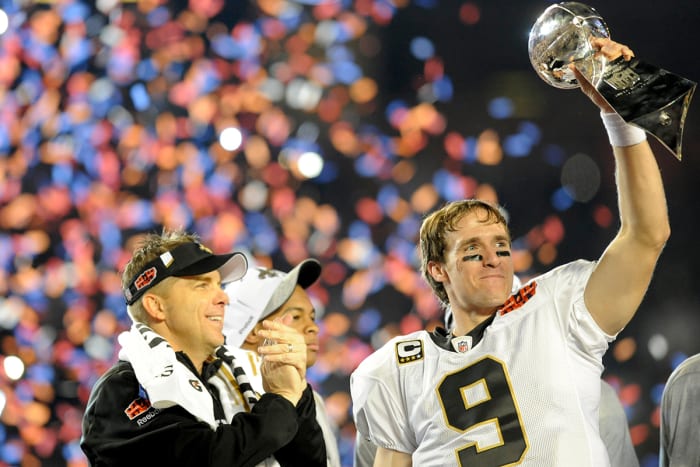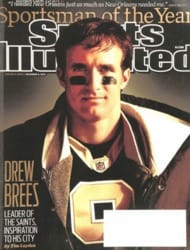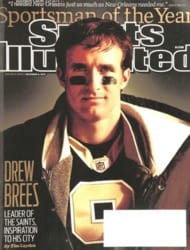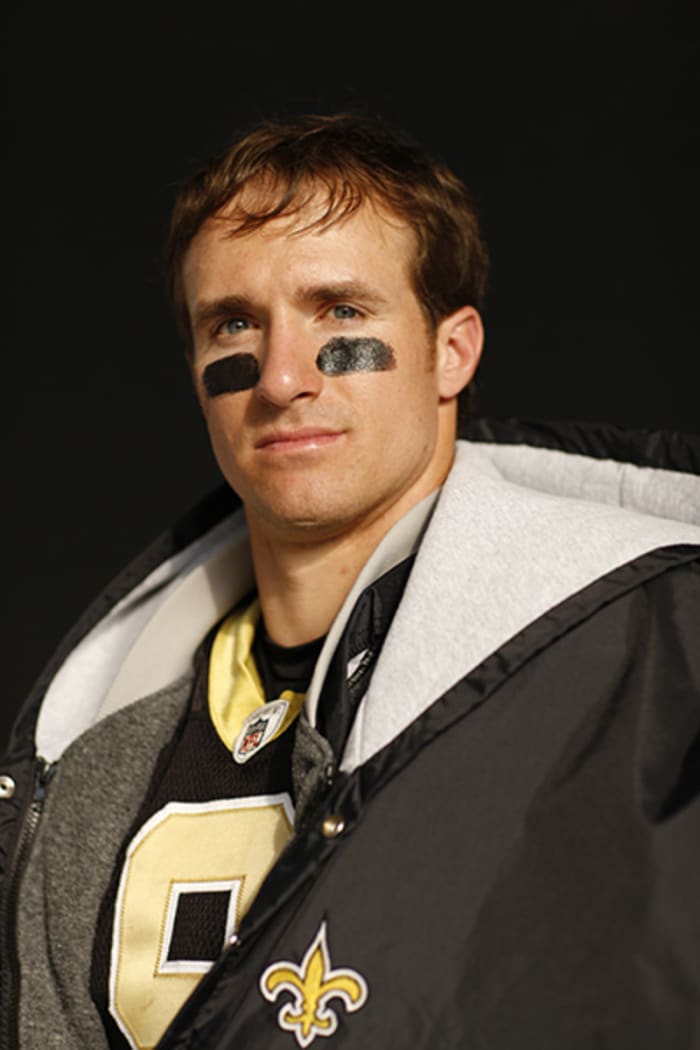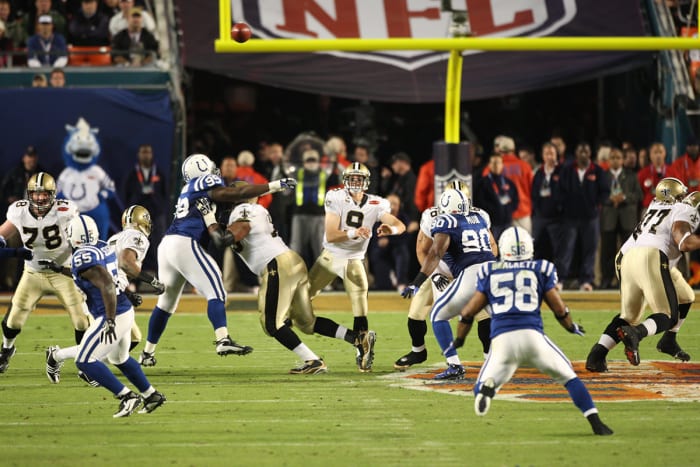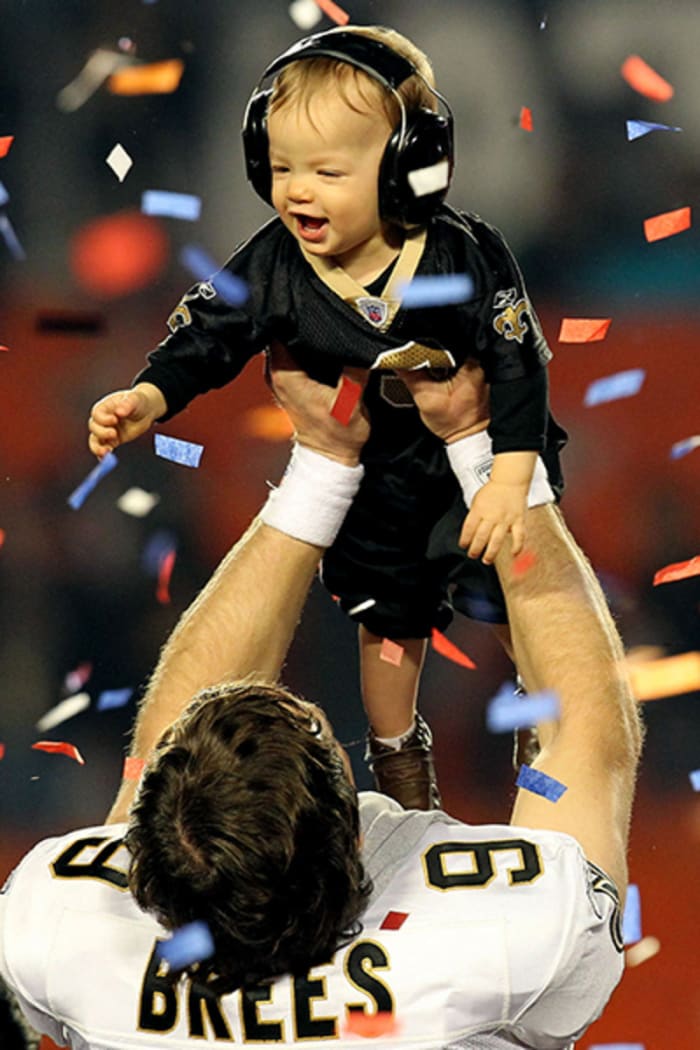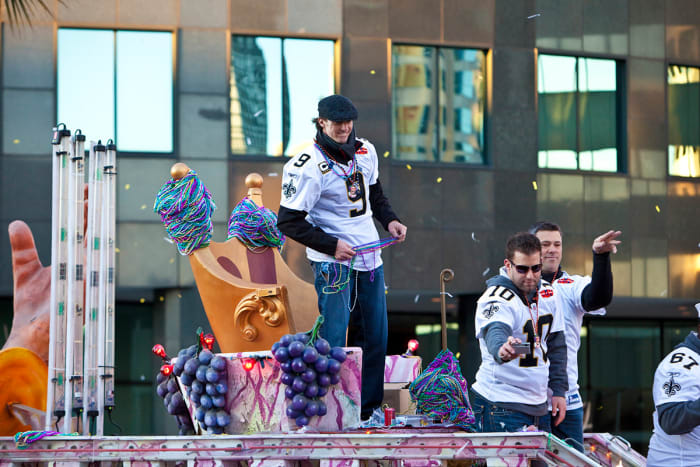Sportsman of the Year: Drew Brees
The little hired bus rumbles north across Lake Pontchartrain on the longest bridge in the U.S., 24 miles of roadway sucked up underneath the front of the vehicle and spit out the back in a monotonous sound track of tires against expansion joints. Thumpthumpthumpthumpthump. New Orleans fading in the distance, northern suburbs ahead on the far shore, water everywhere else. Drew Brees, quarterback of the Super Bowl champion New Orleans Saints, sits idly in a hard seat. When he came to Louisiana five years ago, so much of this was foreign. Now it is deeply familiar. "New Orleans surprised me so much," says Brees. "People told me it was like the Vegas of the South. That's so wrong. This place is in people's blood, and they want you to feel that too." It is the Thursday morning of the Saints' bye week, and players have scattered in a precious escape from the routine and the violence. Brees remains behind for two extra days because there is more to his work than throwing touchdown passes.
Here the bus comes to a stop in front of Magnolia Trace Elementary School, in Mandeville, where Brees will speak to the students as part of an NFL-sponsored community program. Shrieks of joy rise from the sidewalk, where excited children and swooning teachers have gathered to greet their celebrity guest. Brees bounces out of his seat, pulls a black number 9 game jersey over his head and steams toward the front of the bus, clenching both fists. "The kids are pumped!" he shouts. He signs a small collection of memorabilia in the principal's office and then hustles down the pristine hallways of the school. Cafeteria worker Julia Collins of nearby Lacombe sticks her hand in Brees's path; he slaps it emphatically, and Collins runs back to work squealing. Teacher Laura Cangiamilla, seven months pregnant, poses for a photo with Brees. "This is Baby Drew," she says, pointing to the belly stretching her Saints jersey.
Now Brees stands on a stage in the school's gymnasium, and more than 400 students are spread across the tiled floor. He leads them in the Saints' traditional cheer. "Every time I say, 'One, two, three,' you say, 'Who Dat!'" implores Brees. He shouts it half a dozen times or more, cupping his hand next to his ear, and the response is ever louder. Then he asks for quiet, pressing his palms downward against air as if trying to suppress the noise with his hands. There are questions from the kids. What is the greatest challenge of your career? Is it easy to work as a team? Did you do a dance in the locker room after the Super Bowl? This one Brees turns back on the students. "Everybody who thinks they can dance," he shouts, "stand up and give me your best Super Bowl touchdown dance!" Instantly the floor is a beehive of jumping, gyrating, spinning kids, filling the air with celebratory screams. Brees watches like a proud father, or a mischievous co-conspirator.
Then there is another question. A little girl stands and reads nervously from a slip of yellow paper while a teacher holds the microphone. "What is your empowering word?" she asks, then timidly casts her eyes to the floor.
On the stage Brees, 31, raises a microphone to his mouth. Not laughing now. "My empowering word," he says, "is faith."
It is a word that in modern times can polarize—or politicize—an audience, ingratiating some listeners and repelling others. (Not this audience, the adult portion of which gasps in approval.) It's a word that the children have been taught but can't yet fully understand. For Brees the word is more than religion and spirituality, although it has been both of those, increasingly, through the years. Faith is more than Brees's empowering word. It is the central force in his life, slicing across family, football and community, carrying him to the top of his profession and to an iconic status in a still-wounded city that he has helped lift from despair.
When Brees blew out a knee in 11th grade and college recruiters largely abandoned him, it took faith to believe he would someday play college football. When the entire NFL passed on him in the first round of the 2001 draft, when the San Diego Chargers benched him four times and then brought in a young quarterback to replace him, when he tore up his shoulder in December '05, it took faith to believe he would be a star in professional football and lead a team to a Lombardi Trophy. When only New Orleans—the doormat franchise and the ravaged city—believed in him, he believed in New Orleans. When his estranged mother ended her life in the summer of 2009, it took faith for Brees to embrace and understand the complicated and sometimes fleeting power of a family's love. When he rises every weekday at 5:15 a.m., it takes faith to look a cynical public in the eye and nakedly embrace the earnest values of fidelity, fatherhood, service, selflessness and sportsmanship, knowing that the slightest error in behavior will bring a furious blowback.
Yet is faith not also the essence of sport? A fan's unwavering faith in the home team. A player's faith in the workaday value of practice done hard and right to extract the most from his physical gifts. A team's faith that its members can do more together than each could do alone. On the night of Feb. 7, 2010, Drew Brees led the New Orleans Saints to the first Super Bowl championship in the franchise's star-crossed history, a 31--17 victory over the Indianapolis Colts in Miami. He completed 32 of 39 passes for 228 yards and two touchdowns, did not throw an interception and was named the game's most valuable player. For Brees it was the culmination of a four-year climb to a place among the best quarterbacks in football, and for the Saints the crowning moment in a 44-year romance with their home. For that city, nearly lost to a terrible storm, it was a critical step on a very long and ongoing path to recovery. "I needed New Orleans just as much as New Orleans needed me," says Brees. "People in New Orleans needed somebody to care about them. And it was the one place that cared about me."
And cares deeply still, every day. "People come up to Drew and don't say, 'Congratulations,'" says Saints veteran tackle Jon Stinchcomb. "They say, 'Thank you. Thank you for coming here.'"
When the Super Bowl was finished late on that Sunday night, Brees grabbed his one-year-old son, Baylen, and hoisted him skyward into the shower of confetti. The little boy's head was framed by oversized headphones to protect his eardrums from the noise. (He wears them for every game he attends.) Nearby stood Brees's wife, Brittany, unknowingly pregnant with their second child, another boy, Bowen, who would be born in October. And here were a city, a team and a man all reborn, new life reflected in the innocent eyes of a child.
It is for his vital role in that rebirth, for his willingness to immerse himself in New Orleans's recovery while relentlessly pursuing his own, that Drew Brees is SPORTS ILLUSTRATED's 2010 Sportsman of the Year. It is the 57th such honor the magazine has bestowed since its founding in 1954, and in the truest spirit of the award his influence reaches far beyond the walls of the stadium.
It is not a good timeto be anyone's hero. Not with the gaping maw of endless news cycles, cellphone camera photos, social media and gotcha blogs, all lying in wait for the Tiger Moment that reveals the lie and exposes the hypocrisy. And the higher the pedestal, the harder the fall. Brees is acutely aware of this reality but unafraid. "People are waiting, if not to catch you doing something bad," he says, "then to catch you doing something that can be twisted into something that looks bad. But I'm aware of my position. Kids hang on your every word and action. You have an influence on their lives. And I believe this is who I am. It comes pretty naturally to me. I mean, I don't avoid using drugs because kids are watching me; I avoid doing drugs because it's not a good idea to use drugs." In Brees's best-selling memoir, Coming Back Stronger, published last July, he wrote of his marriage to the former Brittany Dudchenko, 34, whom he met in 1999 when both were students at Purdue, "... when I put the ring on Brittany's finger, I said, 'For better or for worse, till death do us part.' Period. No matter how bad it could possibly get, I am committed. It's not about happiness. It's not about a feeling. I committed myself to her for the rest of my life, and I promise never to walk away."
Maybe the idolization of athletes has always been a lousy idea, but the concept will not die soon or easily. It is very much alive on Halloween in New Orleans, where the Saints will play the Steelers in a Sunday-night game at the Superdome (another symbol of the city's climb back from the horror of Hurricane Katrina). By mid-afternoon the streets are bustling with costumed revelers—vampires, superheroes and villains, political figures, Troy Polamalu. But the most ubiquitous costume, by far, is a number 9 football jersey. There are slender women wearing number 9 in tight-fitting pink and gigantic men wearing number 9 in the size of parachutes. There are little children in snuggly number 9s. There is retro number 9, Pro Bowl number 9 and camouflage number 9. There is a cluster of young women with matching T-shirts that say KREWE DU DREW on the back, above a little gold, sequined number 9.
Part of this is organic: Fans wear jerseys to football games, and a lot of them wear the star quarterback's jersey. And while any city with an NFL franchise claims some degree of connection to the team that plays there on Sundays, there is a special bond between the Saints and New Orleans that predates Super Bowl victories and devastating storms. It goes back to the early days of the franchise, born in the fall of 1967, when veteran players like Billy Kilmer and Doug Atkins would stumble down the beer-and-bourbon-soaked streets and share with the townsfolk in the futility that comes from playing the first 20 years of existence without a winning season. Plus it is Halloween. Yet none of this fully explains the number 9 revolution in the city on game day. Says NFL commissioner Roger Goodell, "It's hard to point to a relationship in our league, between a player and a city, that's more meaningful than the Saints and Drew Brees."
New Orleans proper is nearly 70% black, and, says Ronald Markham, the 32-year-old African-American CEO of the New Orleans Jazz Orchestra, "It is a city with many schisms." Yet African-American fans wear number 9 too. "I'll say this: Drew is definitely an honorary brother," says Troy Henry, 50, a black businessman who finished a distant second to Mitch Landrieu in the mayor's race just before this year's Super Bowl. "He transcends race, and he does it with class and dignity."
On a French Quarter side street, Tom Church, a lifelong Saints fan from Jennings, La., is wearing number 9 in black. "It's because of what he did for the city just by coming here," says Church. "And the way he conducts himself. Can you imagine if Ben Roethlisberger lived here? A guy like that would go crazy in this town." Over on Royal Street, one block south of Bourbon, Kelly Hale of New Orleans rocks her shiny gold number 9 jersey. "He's a good family guy," says Hale. "He seems like a nice person. That means a lot."
This love between quarterback and city took root unexpectedly in the winter of 2006. Brees had suffered a catastrophic injury to his throwing shoulder while playing for the Chargers, who had selected him with the first pick of the second round of the 2001 NFL draft. San Diego, which had acquired the rights to Philip Rivers in a draft-day move in 2004, effectively jettisoned the rehabbing Brees by offering him a contract that guaranteed only $2 million. Backup money. The Miami Dolphins showed interest but lowballed Brees when team doctors were skeptical about his chances of coming back.
The Saints, meanwhile, threw themselves at Drew and Brittany Brees. Their courtship was both skilled (a dinner in the chef's kitchen at Emeril's and a film session in which coach Sean Payton promised to tailor his wide-open offense to Brees's strengths) and clumsy (an accidental tour through the parts of the city left most damaged by Katrina barely six months earlier, devastation from which the Saints had hoped to shield Brees). Yet Brees felt something familiar. As a child he had attended weekly Baptist church services; like most of his peers he was there largely from habit rather than devotion. One Sunday at age 17 he felt something stronger, as if the scripture were speaking to him, giving him purpose. Now in 2006, with only the Saints and their bludgeoned home showing belief in him, he sensed that purpose again. "As those few days went by," says Brittany, "Drew and I felt that maybe we were being called to New Orleans for a reason."
The central reason was for Brees to play quarterback, which he has done surpassingly well. That first season he threw for a league-high 4,418 yards and led the Saints on a surprise run to the NFC title game. Two years later he became just the second quarterback in NFL history (after Dan Marino) to throw for 5,000 yards in a season (5,069, to be exact), and in 2009, the Super Bowl season, he completed 70.62% of his throws' the most accurate season ever by an NFL quarterback. "He always had unbelievable instincts, great athletic feet, the whole skill set," says New York Jets offensive coordinator Brian Schottenheimer, Brees's quarterbacks coach for four years in San Diego and still a close friend. "Now, with experience and age, he's just mastered his craft."
Solid quarterbacking alone might have been enough to deify Brees in New Orleans, so beaten was the city after Katrina and so in need of a rallying force. But it is Brees the person who has earned the lasting trust and love of New Orleanians.
Consider: Late in the afternoon of Wednesday, Nov. 10, as Brees was running through a long checklist of bye-week obligations, he detoured to the Lusher Charter School, not far from his home in Uptown New Orleans. The four-story, 77-year-old brick building, previously a traditional high school, was vacant when flooded by Katrina and had slouched into a rotting, mold-choked shelter for displaced residents. In the storm's aftermath New Orleans educators, including Lusher CEO Kathy Hurstell Riedlinger, reopened the building as a charter high school. During the renovation they were contacted by The Brees Dream Foundation, which helped raise $671,000 to restore the school's athletic field, scoreboard and running track. In October 2009 those facilities were christened the Brees Family Field. Drew wrote a $38,000 personal check to rebuild the weight room.
Here Brees jumps from his Mercedes into the middle of the Lusher Lions' football practice. Coach Louis Landrum's team, in its second year of varsity competition, had won four of 10 games and qualified for the Louisiana state playoffs against powerhouse Evangel Christian of Shreveport. Brees calls the players into a circle and animatedly recounts to them the story of David and Goliath before breaking the huddle with a shout. "They've got a tough game," Brees says after leaving the school. "They could lose 70--0 to that team. I wanted to get them fired up." (In fact, Lusher would lose by the relatively respectable margin of 47--6 to a school with multiple Division I prospects.)
In the nearly eight years since The Brees Dream Foundation was established to support cancer research and the care and education of children in need, it has contributed or committed more than $6 million in Louisiana, San Diego and West Lafayette, Ind., home of Purdue. In addition to its work with the Lusher school, the foundation is in the final stages of completing $1 million in funding for the American Cancer Society's Patrick F. Taylor Hope Lodge in New Orleans, a residential facility for patients undergoing chemotherapy, and $100,000 for completion of G.W. Carver High's Field of Dreams in the Ninth Ward.
In total the foundation has worked with nearly 50 New Orleans schools and organizations, providing $300,000 to New Orleans Outreach for after-school assistance; $127,550 to the New Orleans Recreation Department to help with initial costs in the restoration of Pontchartrain Park; $78,000 to Best Buddies Louisiana, which facilitates one-to-one friendships for adults with intellectual disabilities; and $74,000 to the Greater New Orleans Rebuild Child Care Collaborative, to restore child-care facilities lost to Katrina. "A lot of people have a foundation just to have a foundation," says Mark Brunell, an NFL warhorse who was Brees's backup with the Saints in 2008 and '09 and now plays behind Mark Sanchez with the Jets. "Drew has a foundation that does all kinds of things. The guy cares. He's genuine."
From the high school practice in Uptown, Brees stops briefly at home to swap a Saints golf shirt for a dress shirt and sport coat, and then rushes off to Brennan's restaurant in the French Quarter for a meeting of what he calls his Quarterback Club, a group of nine New Orleans businessmen brought together by Brees to pool their creativity and wealth. (Each man commits at least $25,000 a year to Brees's foundation.) "In times of crisis, communities look for leaders, and Drew has become one of those leaders," says club member John Payne, a Caesars Entertainment Corp. executive. "Drew's day job is a high-pressure, full-time job, but he believes passionately that it's part of his role to stay energized and stay involved. He looks at it as a responsibility."
That infectious sincerity is why future Hall of Fame running back LaDainian Tomlinson found himself uncommonly engaged while watching Super Bowl XLIV on television. He met Brees in 1997 when they played together on a high school all-star team in Texas—Brees from Austin, Tomlinson from Waco. "The guy's work ethic stood out from the jump," says Tomlinson. "He was smart, he was a leader. You could just see he was going to be special." In April 2001 the Chargers took Tomlinson with the fifth selection in the draft (Michael Vick went first, to the Falcons, with a pick the Chargers had traded to Atlanta) and chose Brees 27 spots later. The two played together for five seasons; when Brees needed a throwing partner on an off-season afternoon, it was often Tomlinson he'd call. So on that February night in Miami, when Brees took a knee to finish the Super Bowl, Tomlinson felt a deep kinship. "I was screaming," says LT. "It's like I was right there with him. I called him and told him, 'I'm proud of you, man.'"
That sincerity is also why Billy Miller, who played tight end with Brees for four years in New Orleans, and Miller's wife, Rachael, rewrote their will. If the couple were to die or otherwise be incapacitated, the care of their children—sons Caine, 13, and Jaden, 8, and daughter Celeste, 5—would be entrusted to Drew and Brittany Brees. "There is nobody in the world we trust more," says Billy, who now operates the Elite Performance Factory, a gym in Southern California. "Our values line up perfectly."
Miller came to know Brees best not in the locker room or on the field but during USO trips the two have taken together. Brees has been on five such NFL-sponsored trips in the last five years, visiting troops in Afghanistan, Dubai, Guantanamo Bay, Iraq, Kuwait and Japan. His admiration for the military springs from his relationship with his 85-year-old grandfather, Ray Akins, a legendary Texas high school football coach who fought on Okinawa in World War II and still works 100 head of cattle on a ranch in New Baden, Texas. But Brees's appreciation for soldiers goes beyond his family's legacy. "Think of the sacrifices they make," says Brees. "I'm away from my son for a day, and I can't wait to see him. Some of those guys are gone for 15 months."
Brees has also flown in fighter jets a handful of times, once pulling 9.2 G's in an Air Force F-16 with the Thunderbirds. "It gives those guys a chance to promote what they do," Brees says of the rides, "and they appreciate that you're interested." It's also yet another chance to compete. On a tour of Iraq in 2008, Goodell, Brees and Giants defensive end Osi Umenyiora were roommates in Saddam Hussein's former guest palace, where the commissioner got a sense of Brees's fire. So when Goodell flew with the Thunderbirds during Super Bowl week in 2009, he told his pilot, "I've got to do 9 G's, and I can't pass out or throw up, or Drew Brees will never let me hear the end of it." (Goodell made it through fine.)
Perhaps it should be mentioned—just for balance—that Brees is not perfect. Back in eighth grade at St. Andrew's Episcopal School in Austin, young Drew took the occasion of a class party on Lake Austin to moon his classmates from the dock as he jumped into the water. The school suspended him, and worse, his parents held him out of the season-opening flag football game against his team's biggest rival. "It crushed me," says Brees. "And it took me a long time to get over that." Saints legend has it that Brees helped engineer an epic locker room prank so diabolical that nary a teammate will spill the details. And while he's unfailingly cordial with autograph-seekers under most circumstances, don't approach him during private time with his family.
Yet Brees's foibles are rare and refreshingly harmless. "If a father gives his kid a number 9 Saints jersey," says Stinchcomb, "he's probably never going to have to do any explaining about the guy who wears that jersey."
A week into football practice at Purdue in 1997, first-year coach Joe Tiller had grown impatient. His three returning quarterbacks, upperclassmen Billy Dicken and John Reeves and redshirt freshman Clay Walters, were making a mess of the spread passing offense that Tiller intended to unleash on the unsuspecting, plodding Big Ten. Three true freshmen QBs—Drew Brees from Texas, Jim Mitchell from Missouri and Ben Smith from Nebraska—were watching from behind the huddle when Tiller shouted, "Give me one of those young guys to run with the [first team]!"
Smith says, "I took two steps back and was trying to find somewhere to hide, because I sure didn't want to hop out there. It was a very stressful moment—I mean it was intense. Then just as I stepped back, Drew stepped up. He moved right in, took control of the huddle, brought the offense up to the line of scrimmage and ran the play. I remember it was a Four-Go route, and he threw to one of the outside go receivers, and he just put the ball right on the money. I was thinking right there: I'm going to have to find another position." (Epilogue: Smith became not only a starting safety at Purdue but also one of Brees's roommates and, to this day, one of his best friends.)
In retrospect it doesn't seem shocking that Brees was the player who stepped forward and stamped himself on the Purdue program. One year earlier his team at Austin's Westlake High had gone 16--0 and won the Texas 5A state championship game with a 55--15 squeaker over Abilene's Cooper High, and Brees was named the state large-school offensive MVP. But there were issues: He had torn his left ACL in a state playoff game in December of his junior year—scaring off college recruiters—and he was just barely six feet tall. By the middle of Brees's senior season Purdue was the only major program offering a scholarship. (When an SI writer profiled Brees in 1999, his friends chided Brees with the names of quarterbacks recruited by colleges in his home state, including Matt Schobel at Texas A&M and Major Applewhite at Texas.) It was to become a recurring theme in Brees's life: swimming upstream against the collective wisdom.
Brees backed up Dicken that first year and started for the next three. As a senior he led Purdue to its first Rose Bowl in 34 years, and he still holds Big Ten career records for passing yards (11,792) and touchdowns (90). He left behind the indelible memory of a 1998 game against Wisconsin in which he completed 55 of an NCAA-record 83 passes. "There's an It factor in sports," says Greg Olson, who was Brees's quarterbacks coach at Purdue and is now the offensive coordinator for the Tampa Bay Buccaneers. "It's a hard thing to pinpoint. But I'll tell you what: Drew had it."
Evaluators at the next level were skeptical. NFL scouts endlessly debated Brees's height (again), his arm strength and the possible skewing effect of playing in Tiller's wide-open offense (which would be pedestrian by today's standards, just a decade later). At a poke-and-prod for scouts before the 2001 Hula Bowl in Maui, Brees was measured and announced by a stentorian clerk as "five-eleven-seven!" or 5'11 7/8". Brees refused to leave the stage until he was remeasured and announced as "six even!" to applause from the scouts. A month later he flopped at the NFL scouting combine in Indianapolis when coaches supervising drills dulled Brees's enthusiasm by telling him to simply complete throws at three quarters speed rather than passing in a game-speed rhythm. At one point Brees one-hopped a five-yard square-out. In the stands Brian Schottenheimer, who had seen Brees tear up the Big Ten, said out loud, "Who is this guy?"
On a long ride home to Purdue that night, through the mid-winter darkness on I-65, Brees said to a writer in his company, "Now I have to prove myself all over again."
With the Chargers he sat behind Doug Flutie as a rookie, then beat out Flutie in '02, but that only put him on a roller coaster that included four benchings in two seasons. Schottenheimer, whose father, Marty, was the head coach, recalls, "Every time Drew got benched, he would stand on the sideline with his helmet on, chinstrap buckled, ready to go. Sometimes for the whole game. Pretty powerful."
Slowly Brees made himself better. Sean Payton bristles when Brees is described as an overachiever. "He's an amazing athlete," says the Saints' coach. "Quick feet, explosiveness, anticipation." Yet Brees has the mind of an overachiever. He had always been hypercompetitive, but that was no longer enough. Following the 2002 season he began working out extensively with trainer Todd Durkin at Durkin's private gym in San Diego. A year later Brees met with former major league pitcher Tom House, now 63, a pitching coach at USC with a Ph.D. in performance psychology. House helped Brees minimally with throwing mechanics and significantly with the underpinnings of leadership. "Drew wants to please people," says House. "He cares too much. He needed to learn that you can't be everything to all people." What Brees took from the sessions was this: "I was too nice a guy, as a leader. I had this tendency that if people were doing things wrong, I would try to make up for it instead of calling them out. And that will burn you out."
The new Brees kept Rivers at bay for two years; then in the last game of the 2005 season Brees was trying to recover his own fumble when he was driven into the turf by Broncos defensive tackle Gerard Warren. Dr. James Andrews, who operated on Brees's shoulder, called it "one of the most unique injuries of any athlete I've ever treated," a rare 360-degree labrum tear with associated rotator-cuff damage. Andrews repaired the joint with 11 surgical anchors—three or four is common. Brees awoke from surgery right where he was as a senior in high school, as a senior in college and as a fourth-year pro: doubted.
Sean Payton leans forward in his chair, looks at the huge flat-screen wall monitor he uses to watch game tape in his office and begins punching his remote. "I want to show you something," says Payton. "This is amazing. Watch." He cues up the Saints' 34--3 victory over the Carolina Panthers on Nov. 7 and moves ahead to a second-and-five for the Saints from the Carolina 19-yard line with just under three minutes to play in the first half. The play call is Bunch right tear, fake slash 37, weak F, naked right, Z escape, Y boiler. Brees will take a snap, feign a handoff to running back Julius Jones, turn and roll on a bootleg to his right and then make a rapid series of reads before choosing a target and throwing. Three receivers—Robert Meachem, David Thomas and Heath Evans—are "bunched" at the right side of the formation; rookie tight end Jimmy Graham is alone outside on the left.
At the snap the Panthers blitz three men from the right side of the offense and none are effectively blocked, bringing immediate heat on Brees. After Brees fakes to Jones—"With his back to the blitz," says Payton, no small detail—he turns and shuffles right, looking at Meachem, Thomas and Evans. Abruptly Brees switches direction, backpedaling parallel to the line of scrimmage. He plants his right foot, swivels his head to the left and throws across the field to Graham for a touchdown. "You know how people say a quarterback reads A, B, C, D?" says Payton. "That was, like, G. Or H. It blew my mind. We've never even talked about throwing back to Jimmy Graham on that play."
What Brees saw, even before the snap, was that the 6'6" Graham was going to be single-covered by 5'11" cornerback Richard Marshall. Brees was still willing to throw outside to Meachem, except that as soon as Brees snapped his head around from the run fake he saw that the front-side corner was jumping Meachem and that three pass rushers were coming free. "He processed all that in about two seconds," says Payton. "A lot of quarterbacks would have thrown an incompletion toward Meachem or thrown a pick. I still hadn't sorted it all out when Drew got to the sideline. I said, 'How did you get to Graham?' You know how many quarterbacks in the league make that play? Three? Maybe four?"
It was just one play, but one play can reveal a man. The Brees who went under Andrews's scope in 2006 was broken. The Brees who now leads a team and a city is whole. His initial rehab was stunning. "The most remarkable of any patient I've ever treated," Andrews told SI in 2007. Brees's work ethic since has been inspirational. "Follow him around for a day," says Payton. "You'll just go, 'Wow.'" Last July, on the morning after winning four ESPY Awards in Los Angeles and attending parties afterward, Brees met Durkin for a 7 a.m. workout at USC. "We could have done it at nine or 10, or we could have waited until later in the day back in San Diego," says Durkin, "but Drew wants an edge. 'I'm doing it and they're not.'" During the season he continues to do a full set of light-weight, high-rep shoulder exercises four days a week, always thinking back to 2005.
It's Brees who formulates the Saints' raucous pregame chants and leads them like a middle linebacker. It's Brees who stays after practice every day, grooming the Saints' receiving corps, building the communal faith that makes a modern passing offense work. "The biggest thing Drew ever said to me," says slot receiver Lance Moore, an undrafted free agent out of Toledo who has caught 169 passes in five seasons with Brees, "is, 'I trust you.' When Drew trusts you, you can get the ball anytime." Marques Colston, a seventh-round pick out of Hofstra, arrived in New Orleans the same year as Brees, and through endless repetition the two have become arguably the most effective back-shoulder combo in NFL history. "Just being around that great a player, a guy who works so hard," says Colston, "it makes you feel like you have to raise the level of your game."
For precisely that reason Tampa Bay's Olson arranged for his second-year quarterback, Josh Freeman, to spend a week with Brees last summer in San Diego, soaking up the effort (but not discussing schemes, since they play in the same division). Likewise Brian Schottenheimer put Mark Sanchez on the phone with Brees during the off-season. Miller says he gets a steady stream of 5'11" high school clients at his gym who say they want to be the next Drew Brees. "I have to tell them there's a little more to it than being short," says Miller.
Brees juggles the roles of franchise quarterback and local hero by dividing his day into sections and dealing only with the task at hand. Friends have seen it before. "At Purdue we would all study in front of the TV," says Jason Loerzel, a former Purdue linebacker and roommate of Brees's who now lives in New Orleans. "Drew couldn't do it. If the TV was on he had to watch the TV. You couldn't even talk to him." Brees holds rigorously to routine. "He controls every aspect of his life," says Stinchcomb. For instance: Last summer Brees's family moved from one vacation home in San Diego to another, and Brees insisted on renting a U-Haul and doing the job himself. Wiser heads prevailed before Brees started putting couches on his back but not until he had transferred three loads of smaller items.
In the fall of '06 Payton left his office shortly after noon on the bye-week Sunday, and as he climbed into his car, he noticed a solitary figure on the practice field in gray shorts and gray practice T-shirt. It was Brees, dropping back, throwing on air, jogging up the field to the next imaginary line of scrimmage and throwing again.
"What are you doing?" said Payton, incredulous.
"We usually play on Sunday, so I don't want to mess up the routine," said Brees.
"Are we winning or losing?" Payton asked.
"We're winning," said Brees.
Last February in the biggest game of his life, Brees outplayed his surefire Hall of Fame counterpart, the Colts' Peyton Manning. Brees's 82% completion rate was the second best in Super Bowl history. With the game on the line it was Manning, not Brees, who threw a killing pick. And long after the end, Brees rode Saints bus No. 1 back to the team hotel, sitting up front with Payton and assistant coaches Joe Vitt, Greg McMahon, Pete Carmichael and Joe Lombardi, whose grandfather's name was etched into the sterling silver trophy they passed around. "What a special moment," says Brees. "I wished it would never end." It might not, yet. After a 4--3 start the Saints have won four straight, including Thursday's 30--27 comeback win at Dallas, and are battling for a return trip to the Super Bowl.
It is clearly victory that drives Brees, and service that moves him. He is a richly compensated professional with more than 20 sponsorship deals beyond his football contract. Yet it is family that fulfills him. Late on a bye-week afternoon he rushed to Danneel Park, a half mile from the Breeses' Uptown home. The new playground at the west end of the park was alive with small children—climbing, running, falling and rising again to play more in that indomitable way that only children can. It was a spectacular autumn day in the city, warm without humidity, windless and clear. Brees walked to where Brittany stood over three-week-old Bowen's stroller. The little guy was blissfully asleep. Brees kissed his wife and then darted off to find Baylen; soon the Saints' franchise quarterback was climbing up the side of a playscape, the biggest kid in the park. "Oh, no," said Brittany. "Drew is going to hurt himself. We better walk over there. I don't want to make that call to Sean Payton."
Part of Brees's rigid daily schedule includes getting home each Monday through Thursday night (NFL players are usually free on Fridays) at 7:30 to read books to Baylen and put him to sleep before resuming tape study. If Brees is delayed at the team's facility, 15 minutes away in suburban Metairie, Brittany brings the boys to see their father before bedtime. (During the reporting of this story, Brees sent an e-mail saying, "Balance in my life is so important with my four priorities: Faith, Family, Football, Philanthropy. The four F's. LOL.") He is collecting game balls for his boys, five so far for Baylen, one for Bowen, painted and inscribed with their names as if they shared in the wins. Brees says he would like to play long enough in the NFL for his sons to see him in action and remember it.
Brees's own childhood was less than idyllic. His parents, Chip and Mina Brees, both successful lawyers in Austin, divorced when Drew was seven years old and his brother, Reid, was nearly five. (The brothers have a sister, Audrey, a 21-year-old junior at Georgia, from Chip's second marriage.) After the divorce the parents agreed that Drew and Reid would split time between their parents' houses. In the spring of 1999 Drew, then a college sophomore, told SI that the arrangement, while palpably delicate even to an interloper, was acceptable. "My parents get along," he said. He now admits they did not. "The situation was challenging, going back and forth like they did," Chip says. "If I could go back in time and do things differently, I would. But I can't."
Lacking a single household, the boys leaned on each other. "He was a great brother and a great friend for me," says Reid, now 29 and a medical-equipment sales rep in Colorado. "He let me hang with his friends. He beat on me a lot, but in a fun way, and he looked out for me. That's Drew. He looks out for other people."
Last February, two days after the Super Bowl, Brittany took a home pregnancy test, confirming that she was expecting. Bowen was born on Oct. 19, a Tuesday, serendipitously the slowest day of the week for NFL players. Drew was there for the delivery. "There's a saying that the greatest gift you can give a boy is a younger brother," says Drew. "We'd like to have more. We'd like to have a big family."
There is a tragic symmetry to his family's growth. Mina Brees died in Granby, Colo., on Aug. 7, 2009, from a prescription drug overdose; her death was ruled a suicide. Brees's relationship with his mother had been intensely complicated. They were clearly close once: During an SI writer's visit to Austin in 1999, Drew played a spirited tennis match with Mina at her private club and ate brunch with her afterward. They had shared a love of sports; Ray Akins is Mina's dad, and Marty Akins, a former quarterback at Texas, is her brother. Yet Drew and Mina grew apart in the intervening years, over a succession of emotional disagreements. In 2006 Drew publicly asked his mother to stop using his image in advertisements for her judgeship campaign. The episode was sad and unseemly. In his book Brees writes extensively of his efforts to understand their conflict and concludes, in part, "The full truth is that my mom and I had a toxic relationship." He suggests that his mother might have suffered from mental illness.
Brees and his mother barely spoke for the last eight years of Mina's life, but when Brittany became pregnant with Baylen, mother and son began to communicate again. "Things were in the process of getting better," says Brees. "Once Baylen was born, I really hoped she could be a part of his life. We had been communicating back and forth about when that first meeting would be, and then all of sudden she was gone."
Their last exchange, however, had not been uplifting. "Drew and my mother, they never really got back on a good note," says Reid. "I knew Drew felt very bad about that. I'm pretty sure he felt some blame."
But it is part of Brees's spirit that he has grown stronger and more passionate from the loss. And here is faith again, building greater love from tragedy. "I've learned never to take anything for granted," he says, "whether it's a relationship, an opportunity or something in your personal or professional life. I just value little things more. Being with Brittany and my two boys. Time goes by too fast."
NOW THE QUARTERBACK is standing next to a dusty circle in the park, where two little girls slap at a yellow tetherball. Brees is holding Bowen in his arms; the little boy's brown fleece sleeper with bear ears is unzipped in the warm air. The sun is falling and casting long autumn shadows across the earth. The Saints are winning, the city is alive, the family grows. The father drops his head, closes his eyes and softly kisses the son on the forehead. Everything is sweet. Everything is right.
